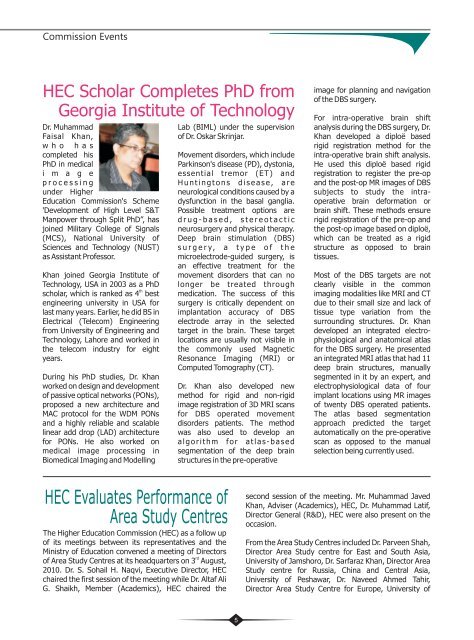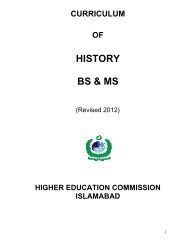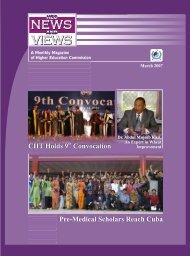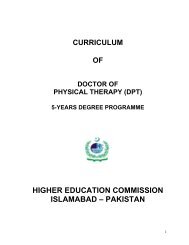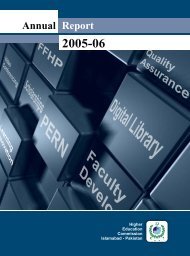Committee Meeting VCs' Committee Meeting - Higher Education ...
Committee Meeting VCs' Committee Meeting - Higher Education ...
Committee Meeting VCs' Committee Meeting - Higher Education ...
You also want an ePaper? Increase the reach of your titles
YUMPU automatically turns print PDFs into web optimized ePapers that Google loves.
Commission Events<br />
HEC Scholar Completes PhD from<br />
Georgia Institute of Technology<br />
Dr. Muhammad<br />
Faisal Khan,<br />
w h o h a s<br />
completed his<br />
PhD in medical<br />
i m a g e<br />
p r o c e s s i n g<br />
under <strong>Higher</strong><br />
<strong>Education</strong> Commission's Scheme<br />
'Development of High Level S&T<br />
Manpower through Split PhD”, has<br />
joined Military College of Signals<br />
(MCS), National University of<br />
Sciences and Technology (NUST)<br />
as Assistant Professor.<br />
Khan joined Georgia Institute of<br />
Technology, USA in 2003 as a PhD<br />
th<br />
scholar, which is ranked as 4 best<br />
engineering university in USA for<br />
last many years. Earlier, he did BS in<br />
Electrical (Telecom) Engineering<br />
from University of Engineering and<br />
Technology, Lahore and worked in<br />
the telecom industry for eight<br />
years.<br />
During his PhD studies, Dr. Khan<br />
worked on design and development<br />
of passive optical networks (PONs),<br />
proposed a new architecture and<br />
MAC protocol for the WDM PONs<br />
and a highly reliable and scalable<br />
linear add drop (LAD) architecture<br />
for PONs. He also worked on<br />
medical image processing in<br />
Biomedical Imaging and Modelling<br />
HEC Evaluates Performance of<br />
Area Study Centres<br />
The <strong>Higher</strong> <strong>Education</strong> Commission (HEC) as a follow up<br />
of its meetings between its representatives and the<br />
Ministry of <strong>Education</strong> convened a meeting of Directors<br />
rd<br />
of Area Study Centres at its headquarters on 3 August,<br />
2010. Dr. S. Sohail H. Naqvi, Executive Director, HEC<br />
chaired the first session of the meeting while Dr. Altaf Ali<br />
G. Shaikh, Member (Academics), HEC chaired the<br />
Lab (BIML) under the supervision<br />
of Dr. Oskar Skrinjar.<br />
Movement disorders, which include<br />
Parkinson's disease (PD), dystonia,<br />
essential tremor (ET) and<br />
H u n t i n g t o n s d i s e a s e , a r e<br />
neurological conditions caused by a<br />
dysfunction in the basal ganglia.<br />
Possible treatment options are<br />
d r u g - b a s e d , s t e r e o t a c t i c<br />
neurosurgery and physical therapy.<br />
Deep brain stimulation (DBS)<br />
s u r g e r y, a t y p e o f t h e<br />
microelectrode-guided surgery, is<br />
an effective treatment for the<br />
movement disorders that can no<br />
longer be treated through<br />
medication. The success of this<br />
surgery is critically dependent on<br />
implantation accuracy of DBS<br />
electrode array in the selected<br />
target in the brain. These target<br />
locations are usually not visible in<br />
the commonly used Magnetic<br />
Resonance Imaging (MRI) or<br />
Computed Tomography (CT).<br />
Dr. Khan also developed new<br />
method for rigid and non-rigid<br />
image registration of 3D MRI scans<br />
for DBS operated movement<br />
disorders patients. The method<br />
was also used to develop an<br />
a l g o r i t h m f o r a t l a s - b a s e d<br />
segmentation of the deep brain<br />
structures in the pre-operative<br />
5<br />
image for planning and navigation<br />
of the DBS surgery.<br />
For intra-operative brain shift<br />
analysis during the DBS surgery, Dr.<br />
Khan developed a diploë based<br />
rigid registration method for the<br />
intra-operative brain shift analysis.<br />
He used this diploë based rigid<br />
registration to register the pre-op<br />
and the post-op MR images of DBS<br />
subjects to study the intraoperative<br />
brain deformation or<br />
brain shift. These methods ensure<br />
rigid registration of the pre-op and<br />
the post-op image based on diploë,<br />
which can be treated as a rigid<br />
structure as opposed to brain<br />
tissues.<br />
Most of the DBS targets are not<br />
clearly visible in the common<br />
imaging modalities like MRI and CT<br />
due to their small size and lack of<br />
tissue type variation from the<br />
surrounding structures. Dr. Khan<br />
developed an integrated electrophysiological<br />
and anatomical atlas<br />
for the DBS surgery. He presented<br />
an integrated MRI atlas that had 11<br />
deep brain structures, manually<br />
segmented in it by an expert, and<br />
electrophysiological data of four<br />
implant locations using MR images<br />
of twenty DBS operated patients.<br />
The atlas based segmentation<br />
approach predicted the target<br />
automatically on the pre-operative<br />
scan as opposed to the manual<br />
selection being currently used.<br />
second session of the meeting. Mr. Muhammad Javed<br />
Khan, Adviser (Academics), HEC, Dr. Muhammad Latif,<br />
Director General (R&D), HEC were also present on the<br />
occasion.<br />
From the Area Study Centres included Dr. Parveen Shah,<br />
Director Area Study centre for East and South Asia,<br />
University of Jamshoro, Dr. Sarfaraz Khan, Director Area<br />
Study centre for Russia, China and Central Asia,<br />
University of Peshawar, Dr. Naveed Ahmed Tahir,<br />
Director Area Study Centre for Europe, University of


